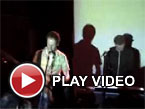 I have yet to encounter a disappointing major Dust-to-Digital release, and this three-disc collection of the choicest bits from John Heneghan's archive of early 78s continues that hot streak beautifully.  Focusing entirely on the many facets of romance (and not skimping on the negative ones), Heneghan wisely opts to skip most of the "serious" artists from the era and instead plunges headlong into the most satisfying examples of hillbilly kitsch, Hawaiiana, casual racism, yodeling, clumsy lewdness, and spectacular poor taste that the '20s and '30s had to offer.
I have yet to encounter a disappointing major Dust-to-Digital release, and this three-disc collection of the choicest bits from John Heneghan's archive of early 78s continues that hot streak beautifully.  Focusing entirely on the many facets of romance (and not skimping on the negative ones), Heneghan wisely opts to skip most of the "serious" artists from the era and instead plunges headlong into the most satisfying examples of hillbilly kitsch, Hawaiiana, casual racism, yodeling, clumsy lewdness, and spectacular poor taste that the '20s and '30s had to offer.
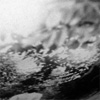 Giuseppe presents an extraordinarily sucessful and ecumenical set of turntable jams on the third and final EP in his Stunt trilogy. With fragmented samples bent into dance cadences and abrupt vocalizations serving as melodic leads, (third) Stunt smacks of both Oval's glitch-worship and Autechre's cold symmetries circa Tri Repetae. More soulful than either, Ielasi stays ahead of his influences by injecting his signature ambient glow into the mix and by adding a touch of dubstep grit.
Giuseppe presents an extraordinarily sucessful and ecumenical set of turntable jams on the third and final EP in his Stunt trilogy. With fragmented samples bent into dance cadences and abrupt vocalizations serving as melodic leads, (third) Stunt smacks of both Oval's glitch-worship and Autechre's cold symmetries circa Tri Repetae. More soulful than either, Ielasi stays ahead of his influences by injecting his signature ambient glow into the mix and by adding a touch of dubstep grit.
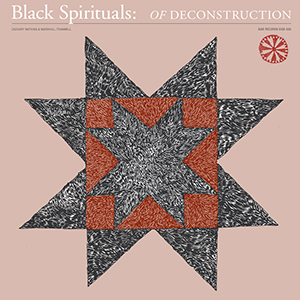 As a duo of drummer Marshall Trammell and guitarist/electronic specialist Zachary James Watkins, Black Spirituals work with unconventional arrangements. The immediate reference point I thought of, Lightening Bolt, is anything but appropriate as far as music goes. While that duo's sound was based upon rapid-fire freak-outs and spastic thrashing, Trammell and James are more deliberate, methodical, and disciplined, but no less thrilling or engaging.
As a duo of drummer Marshall Trammell and guitarist/electronic specialist Zachary James Watkins, Black Spirituals work with unconventional arrangements. The immediate reference point I thought of, Lightening Bolt, is anything but appropriate as far as music goes. While that duo's sound was based upon rapid-fire freak-outs and spastic thrashing, Trammell and James are more deliberate, methodical, and disciplined, but no less thrilling or engaging.
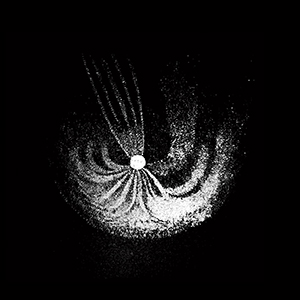 Blood Bright Star's Reuben Sawyer might be primarily known as a visual artist, but his growing discography as a musician indicates that he is a man of many talents. The Silver Head, a four song 12" has him locking into a classically minimalist groove that pulls brilliantly from post punk, krautrock, and metal. The results retain just the right amount of experimentation, while still resulting in a memorable suite of songs.
Blood Bright Star's Reuben Sawyer might be primarily known as a visual artist, but his growing discography as a musician indicates that he is a man of many talents. The Silver Head, a four song 12" has him locking into a classically minimalist groove that pulls brilliantly from post punk, krautrock, and metal. The results retain just the right amount of experimentation, while still resulting in a memorable suite of songs.
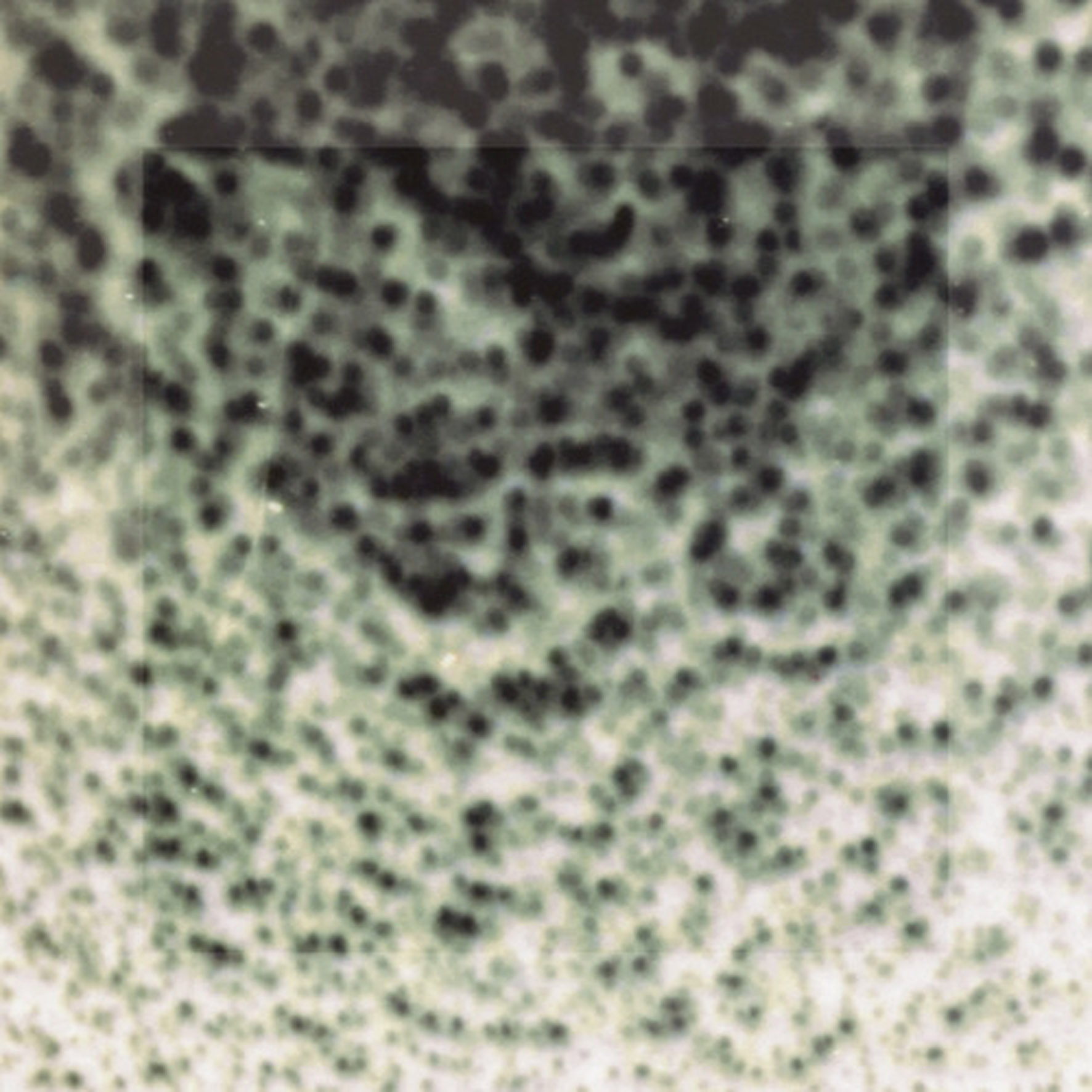 Although Jeff Witscher is best known these days for his work as Rene Hell, he has actually been on the scene for quite a long time and has cycled through a number of both guises and styles.  One of his more beloved early projects was this one, which was reserved for his ambient drone work.  Unfortunately, most of Marble Sky's releases were only available as limited-run cassettes, so this collection of that rare material is quite a useful and timely one.  While there is probably nothing here that anyone will find stylistically revelatory in 2014, Witscher's execution is quite superb, striking the perfect balance between dreamy bliss and frayed, static-gnawed edges.
Although Jeff Witscher is best known these days for his work as Rene Hell, he has actually been on the scene for quite a long time and has cycled through a number of both guises and styles.  One of his more beloved early projects was this one, which was reserved for his ambient drone work.  Unfortunately, most of Marble Sky's releases were only available as limited-run cassettes, so this collection of that rare material is quite a useful and timely one.  While there is probably nothing here that anyone will find stylistically revelatory in 2014, Witscher's execution is quite superb, striking the perfect balance between dreamy bliss and frayed, static-gnawed edges.
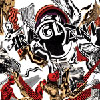 Joseph Raglani uses sine/square wave generator, synth, guitar, voice, melodica, flute and electronics on five intriguing and accessible pieces. The engaging tension, emotional depth and narrative sensibility in Of Sirens Born feels similar to watching a film about explorers entering a strange landscape.
Joseph Raglani uses sine/square wave generator, synth, guitar, voice, melodica, flute and electronics on five intriguing and accessible pieces. The engaging tension, emotional depth and narrative sensibility in Of Sirens Born feels similar to watching a film about explorers entering a strange landscape.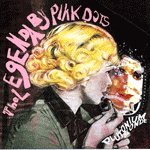 The Dots are as focused and as diverse a group as I can name. For over 25 years they've been releasing record after record of bizarre and colorful music. Even with such a voluminous catalog behind them, their output remains completely unique and peerless. Plutonium Blonde is a trance-like, somewhat awkward record that meshes their eccentric pop sensibilities with dark, aggressive machine music.
The Dots are as focused and as diverse a group as I can name. For over 25 years they've been releasing record after record of bizarre and colorful music. Even with such a voluminous catalog behind them, their output remains completely unique and peerless. Plutonium Blonde is a trance-like, somewhat awkward record that meshes their eccentric pop sensibilities with dark, aggressive machine music.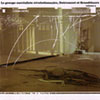 As well as releasing some of the most important and exciting music of the 20th and 21st centuries, Sub Rosa have also acted as archivists when it comes to recordings of important non-musical artists. Previous releases from their aural documents wing include fantastic recordings by Marcel Duchamp, James Joyce, W.S. Burroughs and a series of recordings covering avant garde art in Belgium over the course of the 20th century. This third volume in this Belgian art series covers the main movers and shakers of Belgian contemporary art from just before the Second World War up to the late 1970s. Overall it is a valuable but flawed document that needs more supplemental material to be fully of use to the public and academia at large.
As well as releasing some of the most important and exciting music of the 20th and 21st centuries, Sub Rosa have also acted as archivists when it comes to recordings of important non-musical artists. Previous releases from their aural documents wing include fantastic recordings by Marcel Duchamp, James Joyce, W.S. Burroughs and a series of recordings covering avant garde art in Belgium over the course of the 20th century. This third volume in this Belgian art series covers the main movers and shakers of Belgian contemporary art from just before the Second World War up to the late 1970s. Overall it is a valuable but flawed document that needs more supplemental material to be fully of use to the public and academia at large.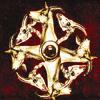 Visual artist Jesse Pep'er, whose hallucinatory artwork adorns the covers of albums by the likes of Edward Ka-spel, Maëror Tri, and Kenji Siratori, finds inspiration in similar territory for his debut album. While not every song evokes the same majestic grotesquerie as his paintings, the best tracks are every bit as otherworldly on this solid, if a bit uneven, album.
Visual artist Jesse Pep'er, whose hallucinatory artwork adorns the covers of albums by the likes of Edward Ka-spel, Maëror Tri, and Kenji Siratori, finds inspiration in similar territory for his debut album. While not every song evokes the same majestic grotesquerie as his paintings, the best tracks are every bit as otherworldly on this solid, if a bit uneven, album. The latest from Poland's Mort Douce is named after a poem by John Siddique. Given the title, I expected to be besieged with insect chittering or else the maddening rush of descending swarms. Instead, the sounds are almost geological, like dropping a microphone into the center of the Earth and amplifying minute tectonic shifts, documenting the secret life of continents.
The latest from Poland's Mort Douce is named after a poem by John Siddique. Given the title, I expected to be besieged with insect chittering or else the maddening rush of descending swarms. Instead, the sounds are almost geological, like dropping a microphone into the center of the Earth and amplifying minute tectonic shifts, documenting the secret life of continents.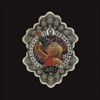 This Portland, Oregon group is probably my current favorite instrumental rock act (basically ever since Battles got all goofy). I've loved all the live shows I've seen and of all their releases on Neurot, Temporary Residence, Important, and Latitude, this, their first release of 2008, is easily my top pick. Here, the group utilize their arsenal of gear and found sounds to showcase their matured compositional skills, exploit some fine riffs, and weave songs together with sounds to make a seamless and blissful 32+ minute record.
This Portland, Oregon group is probably my current favorite instrumental rock act (basically ever since Battles got all goofy). I've loved all the live shows I've seen and of all their releases on Neurot, Temporary Residence, Important, and Latitude, this, their first release of 2008, is easily my top pick. Here, the group utilize their arsenal of gear and found sounds to showcase their matured compositional skills, exploit some fine riffs, and weave songs together with sounds to make a seamless and blissful 32+ minute record. While Grails' second release of the year isn't a mis-step, I simply don't find that I'm captivated by the melodies contained herein. For the second time this year the group have produced a 30+ minute long collection of pieces of epic magnitude, however, I'm often left waiting for songs to develop, and then let down as some of these pieces seem like incomplete thoughts when compared to the previous release.
While Grails' second release of the year isn't a mis-step, I simply don't find that I'm captivated by the melodies contained herein. For the second time this year the group have produced a 30+ minute long collection of pieces of epic magnitude, however, I'm often left waiting for songs to develop, and then let down as some of these pieces seem like incomplete thoughts when compared to the previous release. After having explored the experimental possibilities inherent in the grand piano on his 1986 album Notturno, Tietchens visited the human voice on the 1988 follow up Aus Freude Am Elend. On it, this musical innovator raids recordings of religious ecstatics, people shouting and making love, people singing, and others, using these ‘stolen’ voices to create new frameworks, decontextualised and deconstructed, and in the process rendering the human voice as richly complex an instrument as any woodwind or stringed example. Under Tietchens' analytical gaze and craftsmanlike manipulation, we are left with something that is at once familiar and exotically alien, a veritable menagerie of species paraded before the gaze and designed to both appal and enthral equally.
After having explored the experimental possibilities inherent in the grand piano on his 1986 album Notturno, Tietchens visited the human voice on the 1988 follow up Aus Freude Am Elend. On it, this musical innovator raids recordings of religious ecstatics, people shouting and making love, people singing, and others, using these ‘stolen’ voices to create new frameworks, decontextualised and deconstructed, and in the process rendering the human voice as richly complex an instrument as any woodwind or stringed example. Under Tietchens' analytical gaze and craftsmanlike manipulation, we are left with something that is at once familiar and exotically alien, a veritable menagerie of species paraded before the gaze and designed to both appal and enthral equally. I really do hope that this officially sanctioned seven-inch remix is the start of an avalanche of Jandek reworkings. This inspired idea of placing someone (so wrongly) regarded as unlistenable in a more acceptable modern context is genius.
I really do hope that this officially sanctioned seven-inch remix is the start of an avalanche of Jandek reworkings. This inspired idea of placing someone (so wrongly) regarded as unlistenable in a more acceptable modern context is genius.
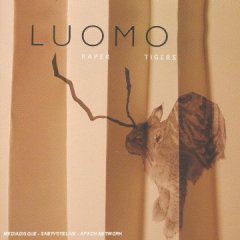 When judged alongside both the artist's masterful debut and its formidable successor, this self-released album tragically underwhelms at just about every percievable opportunity.
When judged alongside both the artist's masterful debut and its formidable successor, this self-released album tragically underwhelms at just about every percievable opportunity.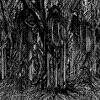 Black One does exactly what is expected from a Sunn O))) record, it drones and feedbacks like a reliable fiend. While it’s nothing groundbreaking in terms of an evolution of their sound, it does provide some subtle new twists on their trademarked detuned riffing.
Black One does exactly what is expected from a Sunn O))) record, it drones and feedbacks like a reliable fiend. While it’s nothing groundbreaking in terms of an evolution of their sound, it does provide some subtle new twists on their trademarked detuned riffing.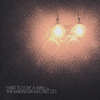 Jason Molina will never be accused of holding back. Through the years as Songs: Ohia and The Magnolia Electric Co, he has proven himself over and over again to be both a prolific songwriter and tireless performer, churning out a stream of excellent albums and perpetually on the road for what seems like 13 months of the year.
Jason Molina will never be accused of holding back. Through the years as Songs: Ohia and The Magnolia Electric Co, he has proven himself over and over again to be both a prolific songwriter and tireless performer, churning out a stream of excellent albums and perpetually on the road for what seems like 13 months of the year.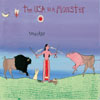 This is the sound of a thrash band sent into the bush andforced to beat their way out with twigs. Everything here, from the warbled acoustic pickin’ to the LightningBolted two-note spasm ascensions, is worn with a genuine conviction, theprimacy of frayed roots, dirty levity and the private knowledge that endurance isgod in this new landscape.
This is the sound of a thrash band sent into the bush andforced to beat their way out with twigs. Everything here, from the warbled acoustic pickin’ to the LightningBolted two-note spasm ascensions, is worn with a genuine conviction, theprimacy of frayed roots, dirty levity and the private knowledge that endurance isgod in this new landscape.The recordings made by Christoph Heeman and Achim Flaam as HirscheNichts Auf Sofa has an appealingly built-in obsolescence. The bulk ofthe original catalog was released in small cassette and vinyl editionson Germany's DOM records, and with the exception of the five LPsrecently re-released in deluxe CD editions, most of the music remainsextremely scarce, making it great fodder for obsessive collectors.Unfortunately, many HNAS-related satellite projects such as MiesesGegonge, Duka Bass Band and Speck Nusseck have remained unreleased andlargely ignored. Recently G. Gonge Produktionen released this series ofCD-Rs, issuing six of the rarest DOM cassettes. Be warned: these discsare unofficial bootlegs, the original recordings have not beendigitally remastered, there are no bonus tracks and the packagingconsists of xeroxes of the original tape sleeves. Despite theselimitations, it's great to be able to hear the music again for thefirst time. Listening to these recordings 20 years after makes menostalgic for a lost age when esoteric and experimental underground DIYcassette labels flourished, not yet having been rendered obsolete bythe digital revolution. Creeping into this world of throwaway musiqueconcrete, off-kilter improvisation and drug-addled musical in-jokes islike rummaging through the dusty attic of a 90-year-old schizophrenicwho obsessively saves everything; it's a series of clues with nosolution, flashes of momentary inspiration and frustratingly stillbornideas. In short, the stuff of life.
MIESES GEGONGE, "LIVE" 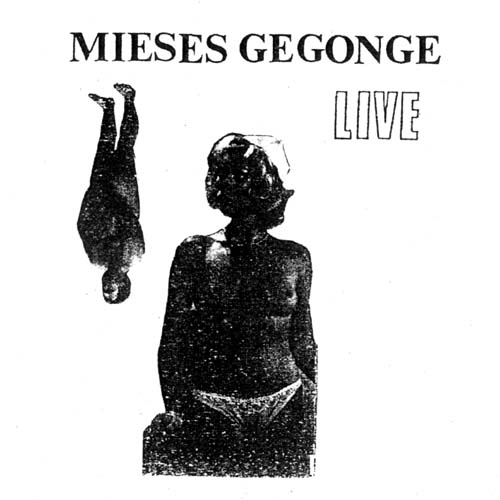 Mieses Gegonge are something of a mystery, but they appear to be asister group to HNAS, having shared the credit for the first HNAS albumAbwassermusik. The material on this CD is culled from two liveperformances in 1985. The sound is very strange indeed: a twistedcombination of arrhythmic percussion together with horribly phased anddistorted vocals. The treated voices and drums are immediatelyreminiscent of the "psych-out" sections of classic Can constructionslike "Halleluwah" and "Aumgn." However, Mieses Gegonge is all psych-outwith no breaks for coherence. Bizarre chants and ululations quaver andripple across layers of randomly beaten skins and gongs, reverbed andwarped into oblivion. If anyone attending these performances wasn't onat least three hits of fine Dusseldorf acid, I feel sorry for them. Therecording is shitty and wracked with distortion, which adds interestingbursts of high-frequency noise that contribute to the lunacy. Imagine apost-lobotomy 23 Skidoo trying to cover The Master Musicians of Jajoukawith nothing but a saw and a zither and William Bennett playing oneroom over, and you might begin to approximate the experience of Live.It's a uniquely fucked sound that will appeal to jaded listenerslooking for a surreal thrill.
Mieses Gegonge are something of a mystery, but they appear to be asister group to HNAS, having shared the credit for the first HNAS albumAbwassermusik. The material on this CD is culled from two liveperformances in 1985. The sound is very strange indeed: a twistedcombination of arrhythmic percussion together with horribly phased anddistorted vocals. The treated voices and drums are immediatelyreminiscent of the "psych-out" sections of classic Can constructionslike "Halleluwah" and "Aumgn." However, Mieses Gegonge is all psych-outwith no breaks for coherence. Bizarre chants and ululations quaver andripple across layers of randomly beaten skins and gongs, reverbed andwarped into oblivion. If anyone attending these performances wasn't onat least three hits of fine Dusseldorf acid, I feel sorry for them. Therecording is shitty and wracked with distortion, which adds interestingbursts of high-frequency noise that contribute to the lunacy. Imagine apost-lobotomy 23 Skidoo trying to cover The Master Musicians of Jajoukawith nothing but a saw and a zither and William Bennett playing oneroom over, and you might begin to approximate the experience of Live.It's a uniquely fucked sound that will appeal to jaded listenerslooking for a surreal thrill.
samples:
DUKA BASS BAND, "FRAULEIN CASANOVA"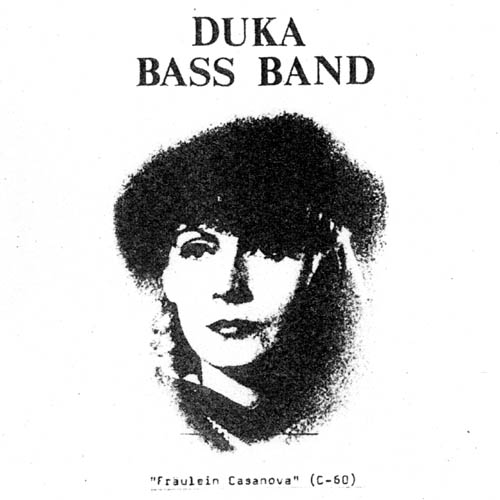 Duka Bass Band appears to be a trio consisting of Lasse Laudrup, Martin B. Klaeren and Sven Nykvist. On Fraulein Casanova,they are joined on a few tracks by Christoph Heeman and Achim P. LiKhan of HNAS, and Heeman also produced the album. The Duka Bass Band'ssound is a fuzzy, primitive clamor of clueless post-jazz improvisationsthat meander aimlessly and appear to fly in several differentdirections at once. It has a certain amateurish quality and a creepysubterranean feel that appeals to me, although I couldn't say exactlywhy. In the exclusively German liner notes, Heeman muses "Fraulein Casanovais for me a jerking step forward into the natural alreadyness ofmusic." Perhaps this dodgy AltaVista translation should not be trusted,but it's as good an explanation as any for the oddly surreal freeplaying on display here. The opening track is the seven-minute"Zauberformeln," which means 'magical formulas.' It's an aptdescription for the mysterious forces that transform the sound ofdeficiently played clarinet, organs and drums into a strange alchemicalgold that is more than the sum of its components. There are momentsthroughout Fraulein Casanova that touch on elements of firemusic improvs, belabored Shaggs-style guitar, and in the case of thelast track (whose title loosely translates to "For God, 1000 Years IsLike a Day"), a ramshackle psych-folk jam not dissimilar from therecent work of Sunburned Hand of the Man. This is my personal favoriteof the six bootlegs, and I look forward to further recordings by thismysterious post-industrial jazz trio materializing at some future point.
Duka Bass Band appears to be a trio consisting of Lasse Laudrup, Martin B. Klaeren and Sven Nykvist. On Fraulein Casanova,they are joined on a few tracks by Christoph Heeman and Achim P. LiKhan of HNAS, and Heeman also produced the album. The Duka Bass Band'ssound is a fuzzy, primitive clamor of clueless post-jazz improvisationsthat meander aimlessly and appear to fly in several differentdirections at once. It has a certain amateurish quality and a creepysubterranean feel that appeals to me, although I couldn't say exactlywhy. In the exclusively German liner notes, Heeman muses "Fraulein Casanovais for me a jerking step forward into the natural alreadyness ofmusic." Perhaps this dodgy AltaVista translation should not be trusted,but it's as good an explanation as any for the oddly surreal freeplaying on display here. The opening track is the seven-minute"Zauberformeln," which means 'magical formulas.' It's an aptdescription for the mysterious forces that transform the sound ofdeficiently played clarinet, organs and drums into a strange alchemicalgold that is more than the sum of its components. There are momentsthroughout Fraulein Casanova that touch on elements of firemusic improvs, belabored Shaggs-style guitar, and in the case of thelast track (whose title loosely translates to "For God, 1000 Years IsLike a Day"), a ramshackle psych-folk jam not dissimilar from therecent work of Sunburned Hand of the Man. This is my personal favoriteof the six bootlegs, and I look forward to further recordings by thismysterious post-industrial jazz trio materializing at some future point.
samples:
SPECK NUSSECK & DIE LEGENDAREN FETTBOYS, "DANCEMUSIC FUR DICKE BACKER"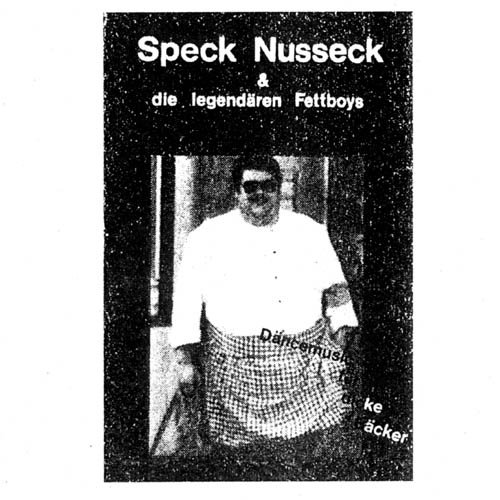 It's anyone's guess who the hell Speck Nusseck or The Legendary FatBoys are, or where they come from, or what masochistic weirdoencouraged them to record Dancemusic Fur Dicke Backer.The answers to these questions are not readily apparent, and they maynever become clear. The only thing we have to go on are the seven songscomprising Dancemusic, for which the word "annoying" seemswoefully inadequate. Plodding drum machine rhythms and randomly pluckedbass compete with vocals shouted into a megaphone backed by lamekeyboard effects which underscore the mess. I'm tempted to call thisoutsider music, but that would suggest that it is charmingly sincereand/or amateurish music that has worthwhile elements. Unfortunately,Speck Nusseck are neither charming nor sincere, and they are not worthanyone's time. They appear to be influenced by the edgy post-punk ofSection 25, the noisy effrontery of Throbbing Gristle and even themotorik beats of Neu!, but they are terribly unequal to the job ofpaying homage to their heroes. The best thing that can be said aboutthis album is that it is mercifully short, and would likely make anexcellent way to get rid of the last few people still hanging out inyour living room after the party is over.
It's anyone's guess who the hell Speck Nusseck or The Legendary FatBoys are, or where they come from, or what masochistic weirdoencouraged them to record Dancemusic Fur Dicke Backer.The answers to these questions are not readily apparent, and they maynever become clear. The only thing we have to go on are the seven songscomprising Dancemusic, for which the word "annoying" seemswoefully inadequate. Plodding drum machine rhythms and randomly pluckedbass compete with vocals shouted into a megaphone backed by lamekeyboard effects which underscore the mess. I'm tempted to call thisoutsider music, but that would suggest that it is charmingly sincereand/or amateurish music that has worthwhile elements. Unfortunately,Speck Nusseck are neither charming nor sincere, and they are not worthanyone's time. They appear to be influenced by the edgy post-punk ofSection 25, the noisy effrontery of Throbbing Gristle and even themotorik beats of Neu!, but they are terribly unequal to the job ofpaying homage to their heroes. The best thing that can be said aboutthis album is that it is mercifully short, and would likely make anexcellent way to get rid of the last few people still hanging out inyour living room after the party is over.
samples:
HNAS, "ICH KANNTE EINEN GUMMIBAUM"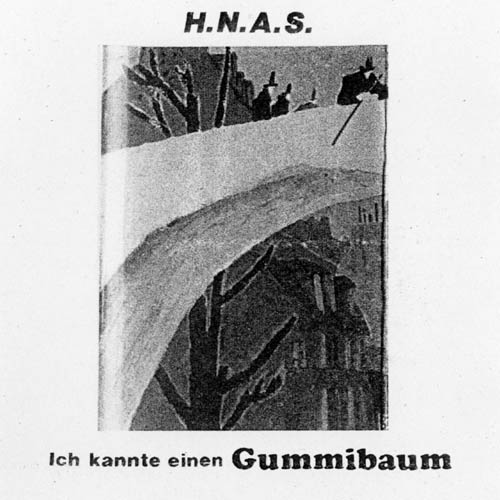 HNAS are invariably compared to Nurse With Wound, and more often thannot to the detriment of Heeman and company. It seems that they areforever doomed, relegated to an obscure footnote in the NWW story bywriters and critics, who seem unable to realize that HNAS use their ownunique strategies to portray their particular brand of audiosurrealism. HNAS does not revel in the exaggerated psychedelicgrotesqueries of Steven Stapleton's work — their tactics are sloppier,less calculated, and in many cases even stranger. The seminal krautrockband Faust is a much more analogous comparison. Heeman and Khan's pathwas paved by Faust's willfully messy LPs that cycled through disparatehalf-formed musical ideas and random piss-takes. Ich Kannte Einen Gummibaumis a good demonstration of their distinct sound. The first trackcreates a creeping quasi-rhythmic industrial atmosphere, recalling theearly work of Laibach, but Heeman's deliberately muddy production andmuffled sounds of voices, distant guitar solos and graveyard organs adda nebulous mystery belonging to HNAS alone. The second track, "Kill DenAchim" is culled from a live performance, and finds the band in agloriously anarchic phase. A woman screams violent provocations backedby oblivious, repetitive electric guitar licks and sheets of live noiseand distortion. On "Ich bin ja besser," a disco record is obscured bylayers of cacophonous whalesong. Track five loosely translates to "AWinter Without Skin Problems," in which a disintegrating chamberorchestra fights against encroaching electronic squalls. The last trackis an extended 25-minute construction combining silly-cum-sinistervocal mutations alongside nonsense percussion. The lunacy segues into alengthy section of concrete tape edits, combining impressionistic pianopieces with field recordings and samples drawn from German televisionand radio.
HNAS are invariably compared to Nurse With Wound, and more often thannot to the detriment of Heeman and company. It seems that they areforever doomed, relegated to an obscure footnote in the NWW story bywriters and critics, who seem unable to realize that HNAS use their ownunique strategies to portray their particular brand of audiosurrealism. HNAS does not revel in the exaggerated psychedelicgrotesqueries of Steven Stapleton's work — their tactics are sloppier,less calculated, and in many cases even stranger. The seminal krautrockband Faust is a much more analogous comparison. Heeman and Khan's pathwas paved by Faust's willfully messy LPs that cycled through disparatehalf-formed musical ideas and random piss-takes. Ich Kannte Einen Gummibaumis a good demonstration of their distinct sound. The first trackcreates a creeping quasi-rhythmic industrial atmosphere, recalling theearly work of Laibach, but Heeman's deliberately muddy production andmuffled sounds of voices, distant guitar solos and graveyard organs adda nebulous mystery belonging to HNAS alone. The second track, "Kill DenAchim" is culled from a live performance, and finds the band in agloriously anarchic phase. A woman screams violent provocations backedby oblivious, repetitive electric guitar licks and sheets of live noiseand distortion. On "Ich bin ja besser," a disco record is obscured bylayers of cacophonous whalesong. Track five loosely translates to "AWinter Without Skin Problems," in which a disintegrating chamberorchestra fights against encroaching electronic squalls. The last trackis an extended 25-minute construction combining silly-cum-sinistervocal mutations alongside nonsense percussion. The lunacy segues into alengthy section of concrete tape edits, combining impressionistic pianopieces with field recordings and samples drawn from German televisionand radio.
samples:
HNAS, "THE UNCOLLECTED ULTRA RARE & UNRELEASED"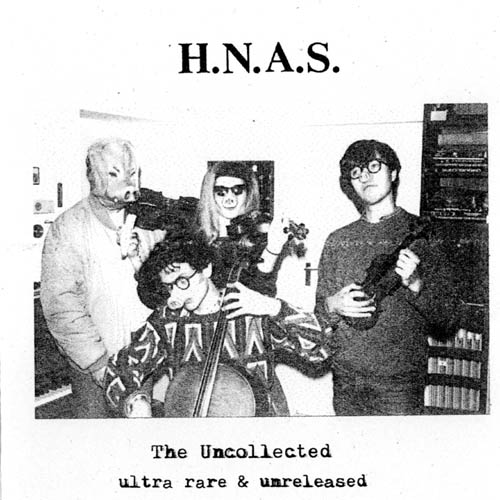 Another in a trilogy of rare HNAS cassette titles issued by G. Gonge, The Uncollectedis an odds-and-sods anthology, collecting tracks from out-of-printcompilations and rare cassettes, as well as some previously unreleasedmaterial. As such it is an uneven and incoherent listen, but with aband as unorthodox as HNAS, that's hardly a problem. Most of the tracksare in the jagged cut-and-splice style recognizable from mid-80's HNASalbums. It feels a bit like an audio version of the absurdist photo andtext collages found in early punk zines. More than once these piecesdigress into the stoned chatter and laughter of a group of youngGermans, who I can only assume to be Christoph, Achim, and friends.Recording and including this unseemly screwing-about on their albumstakes the music out of the realm of the dryly conceptual oravant-garde, and into the "anything goes" realm of DIY homeexperimentalism. That said, there is also much that is musicallyimpressive among these songs, as in the noir queasiness of "DemPetermann zu Ehren," a dark piano dirge. "Was wir von Cassetten halten4" is a phased electronic piece with looped sing-song vocals recallsearly Current 93. "Wie ein Bock am Michekstag" is similar to the workPeople Like Us, juxtaposing dialogue samples from a "Learn to SpeakSwedish" tape with a kitschy exotica loop. The final song is a rare andlovely track by Duka Bass Band: more demented post-jazz with sinisterundertones.
Another in a trilogy of rare HNAS cassette titles issued by G. Gonge, The Uncollectedis an odds-and-sods anthology, collecting tracks from out-of-printcompilations and rare cassettes, as well as some previously unreleasedmaterial. As such it is an uneven and incoherent listen, but with aband as unorthodox as HNAS, that's hardly a problem. Most of the tracksare in the jagged cut-and-splice style recognizable from mid-80's HNASalbums. It feels a bit like an audio version of the absurdist photo andtext collages found in early punk zines. More than once these piecesdigress into the stoned chatter and laughter of a group of youngGermans, who I can only assume to be Christoph, Achim, and friends.Recording and including this unseemly screwing-about on their albumstakes the music out of the realm of the dryly conceptual oravant-garde, and into the "anything goes" realm of DIY homeexperimentalism. That said, there is also much that is musicallyimpressive among these songs, as in the noir queasiness of "DemPetermann zu Ehren," a dark piano dirge. "Was wir von Cassetten halten4" is a phased electronic piece with looped sing-song vocals recallsearly Current 93. "Wie ein Bock am Michekstag" is similar to the workPeople Like Us, juxtaposing dialogue samples from a "Learn to SpeakSwedish" tape with a kitschy exotica loop. The final song is a rare andlovely track by Duka Bass Band: more demented post-jazz with sinisterundertones.
samples:
HNAS, "DIE DREHORGEL ALS FEUERSPRITZE"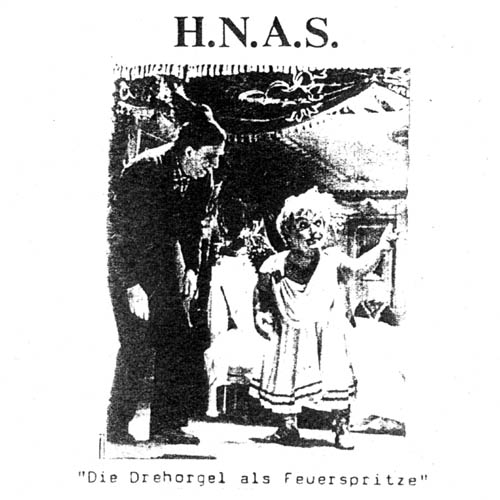 The first track of Die Drehorgel Als Feuerspritzewas recorded live in 1984, the title roughly translating to "TheParadoxes and Secret Sciences of the World." It's one of the bestpieces I've heard HNAS' prolific oevre, a murky sound sculpturecomprising long-form synth drones and gothic organ swells. The sticky,shapeless drones and burbling moogs converge into caverns filled withfloating stone obelisks that chisel strange patterns into thelistener's consciousness. The piece develops using an interior logic, adreamlike coherence that slowly asserts itself over the course of halfan hour. "Barenklammer" was recorded for an as-yet-unreleased HNASvideo, and contains some of the same source material as the firsttrack, quite reminiscent of the synthesizer arpeggiations andavant-rock noise that characterized Tangerine Dream's Electronic Meditationalbum. The third track pushes my PANIC buttons: a manipulative noisepiece that plays like Bernard Herrmann's string tribute to Whitehouse.The layered voices and random bass slaps of the last track evokes Crasscovering a Hildegaard von Bingen chant while tripping on mushrooms.This is a concentrated effort by HNAS, and its single-minded absurditymakes it the most consistent of the three HNAS CD-Rs reissued by G.Gonge. As more of these rare recordings come to light, perhaps HNAS canfinally crawl out of the long shadow cast by Nurse With Wound andreveal themselves to be every bit as unique, talented and vital.
The first track of Die Drehorgel Als Feuerspritzewas recorded live in 1984, the title roughly translating to "TheParadoxes and Secret Sciences of the World." It's one of the bestpieces I've heard HNAS' prolific oevre, a murky sound sculpturecomprising long-form synth drones and gothic organ swells. The sticky,shapeless drones and burbling moogs converge into caverns filled withfloating stone obelisks that chisel strange patterns into thelistener's consciousness. The piece develops using an interior logic, adreamlike coherence that slowly asserts itself over the course of halfan hour. "Barenklammer" was recorded for an as-yet-unreleased HNASvideo, and contains some of the same source material as the firsttrack, quite reminiscent of the synthesizer arpeggiations andavant-rock noise that characterized Tangerine Dream's Electronic Meditationalbum. The third track pushes my PANIC buttons: a manipulative noisepiece that plays like Bernard Herrmann's string tribute to Whitehouse.The layered voices and random bass slaps of the last track evokes Crasscovering a Hildegaard von Bingen chant while tripping on mushrooms.This is a concentrated effort by HNAS, and its single-minded absurditymakes it the most consistent of the three HNAS CD-Rs reissued by G.Gonge. As more of these rare recordings come to light, perhaps HNAS canfinally crawl out of the long shadow cast by Nurse With Wound andreveal themselves to be every bit as unique, talented and vital.
samples:
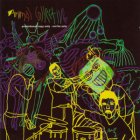 Fat Cat's reissue of the first two Animal Collective releases on one double-disc should not only come as a pleasant surprise to those who discovered the group with this year's excellent Here Comes The Indian, but should also raise the question why it took almost 4 years for the Brooklyn-based project to be courted by a large label. Created by and originally credited to only two Animal Collective members, Spirit They've Gone, Spirit They've Vanished was self-released on Animal Records in 2000.
Fat Cat's reissue of the first two Animal Collective releases on one double-disc should not only come as a pleasant surprise to those who discovered the group with this year's excellent Here Comes The Indian, but should also raise the question why it took almost 4 years for the Brooklyn-based project to be courted by a large label. Created by and originally credited to only two Animal Collective members, Spirit They've Gone, Spirit They've Vanished was self-released on Animal Records in 2000.


